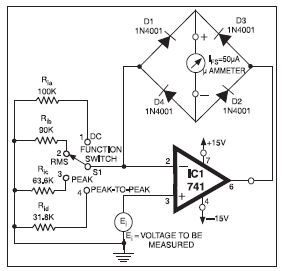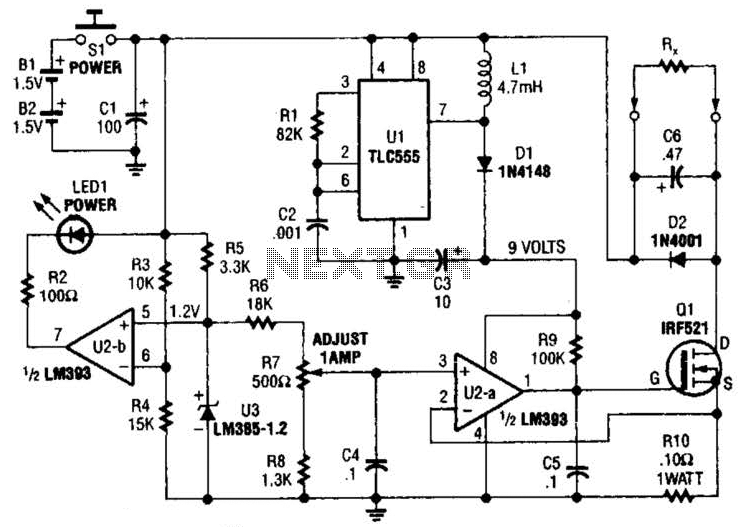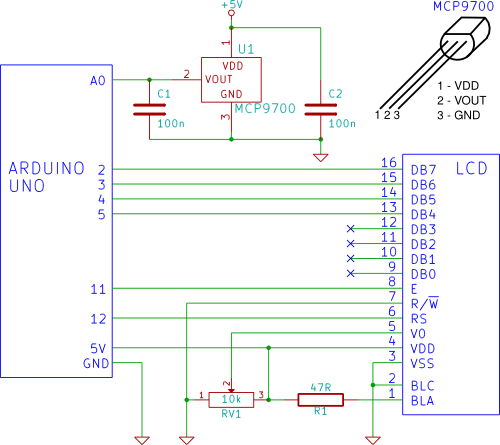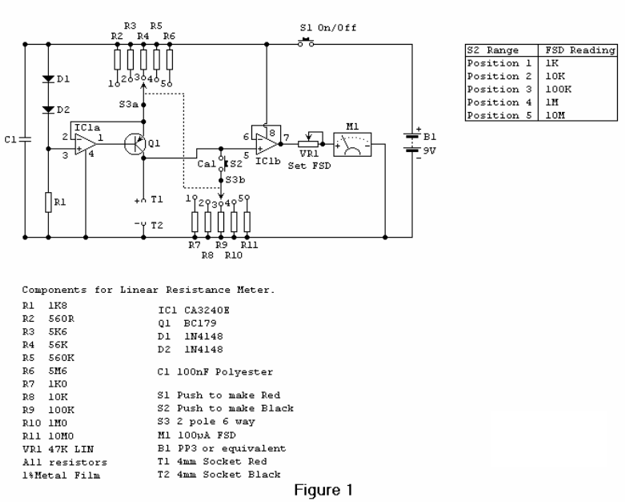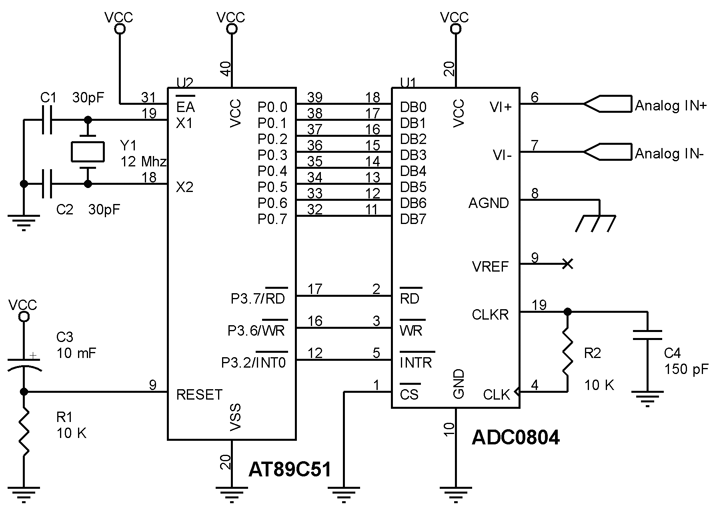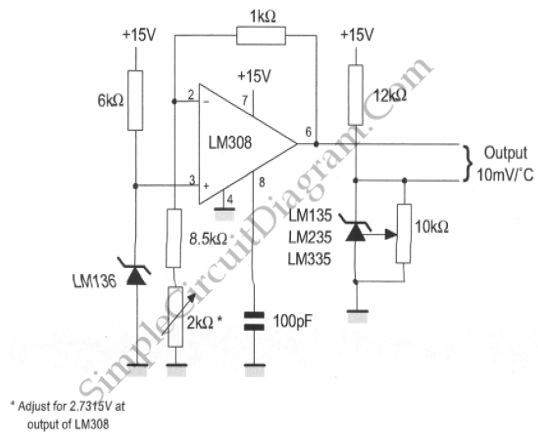
Linearized platinum resistance thermometer
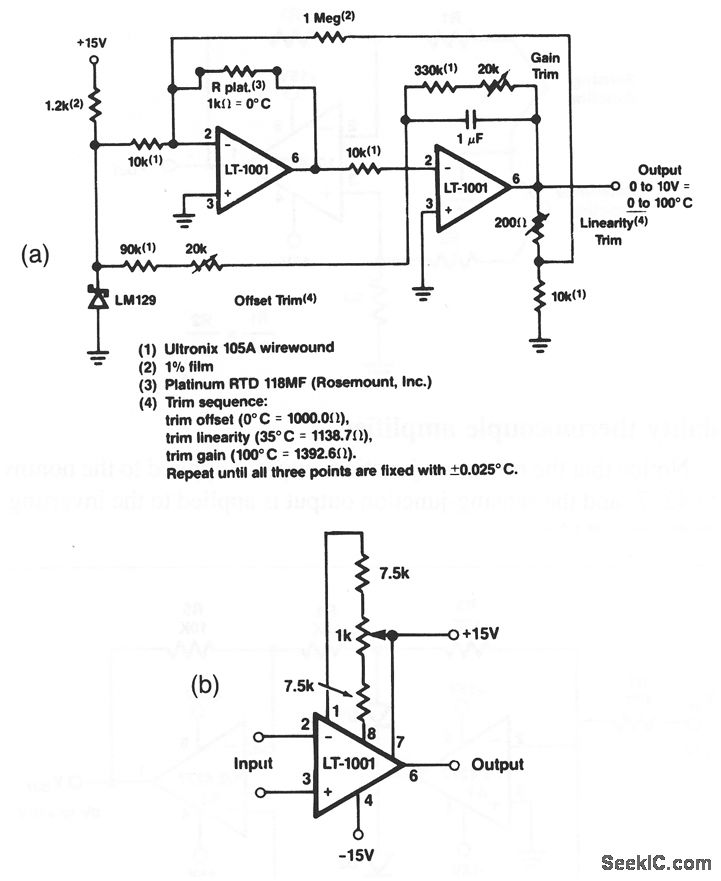
This circuit demonstrates an accuracy of ±0.025 °C across a temperature range of 0 °C to 100 °C, based on the specified values. The LT-1001's input offset voltage and its temperature drift are permanently calibrated to a low level during wafer testing. If additional adjustment of the offset voltage (VOS) is required, the nulling circuit illustrated in Figure 10-4B can be utilized without adversely affecting the temperature drift. The offset circuit depicted in Figure 10-4B offers an approximate null range of ±100 V.
The described circuit utilizes the LT-1001 precision operational amplifier, which is known for its low input offset voltage and minimal drift with temperature variations. This makes it suitable for applications requiring high accuracy in temperature measurement. The calibration process at the wafer level ensures that the device is optimized for performance before it is integrated into the final application.
When adjustments to the input offset voltage are needed, the nulling circuit (Figure 10-4B) can be employed. This circuit is designed to provide a means of fine-tuning the offset without introducing additional drift, thereby maintaining the circuit's overall accuracy. The null range of approximately ±100 V indicates that significant adjustments can be made to accommodate variations in system requirements or component tolerances.
In practice, the implementation of this circuit involves careful consideration of the surrounding components, including resistors and capacitors that may be used in conjunction with the LT-1001. Proper layout and thermal management are essential to maintain accuracy and reliability, especially in environments where temperature fluctuations are expected. The circuit's design should also take into account power supply decoupling to minimize noise and improve performance.
Overall, this precision temperature measurement circuit exemplifies the integration of advanced electronic components to achieve high levels of accuracy and stability, making it suitable for a wide range of applications in industrial, medical, and scientific fields.With the values shown, this circuit has a ±0. 025 °C accuracy over 0 ° to 100 °C. The input offset voltage of the LT-1001, and its drift with temperature, are permanently trimmed at wafer test to a low level. However, if further adjustment of VOS is necessary, nulling with the circuit of Fig. 10-4B will not degrade drift with temperature. The Fig. 10-4B offset circuit has an approximate null range of ±100 V. o Raytheon U near Integrated a rcuts 1989, p. 4-45. 🔗 External reference
The described circuit utilizes the LT-1001 precision operational amplifier, which is known for its low input offset voltage and minimal drift with temperature variations. This makes it suitable for applications requiring high accuracy in temperature measurement. The calibration process at the wafer level ensures that the device is optimized for performance before it is integrated into the final application.
When adjustments to the input offset voltage are needed, the nulling circuit (Figure 10-4B) can be employed. This circuit is designed to provide a means of fine-tuning the offset without introducing additional drift, thereby maintaining the circuit's overall accuracy. The null range of approximately ±100 V indicates that significant adjustments can be made to accommodate variations in system requirements or component tolerances.
In practice, the implementation of this circuit involves careful consideration of the surrounding components, including resistors and capacitors that may be used in conjunction with the LT-1001. Proper layout and thermal management are essential to maintain accuracy and reliability, especially in environments where temperature fluctuations are expected. The circuit's design should also take into account power supply decoupling to minimize noise and improve performance.
Overall, this precision temperature measurement circuit exemplifies the integration of advanced electronic components to achieve high levels of accuracy and stability, making it suitable for a wide range of applications in industrial, medical, and scientific fields.With the values shown, this circuit has a ±0. 025 °C accuracy over 0 ° to 100 °C. The input offset voltage of the LT-1001, and its drift with temperature, are permanently trimmed at wafer test to a low level. However, if further adjustment of VOS is necessary, nulling with the circuit of Fig. 10-4B will not degrade drift with temperature. The Fig. 10-4B offset circuit has an approximate null range of ±100 V. o Raytheon U near Integrated a rcuts 1989, p. 4-45. 🔗 External reference
